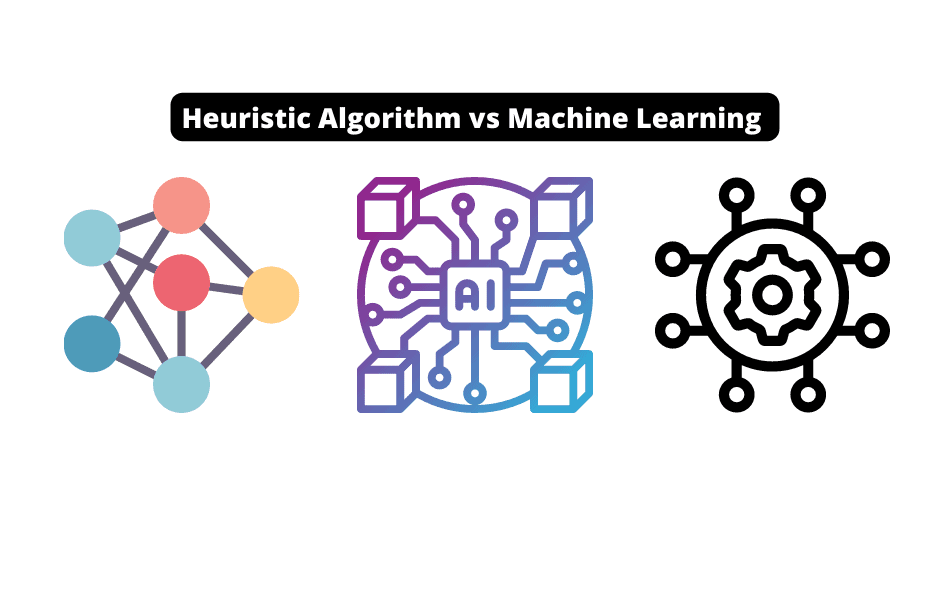Today, we’re exploring the differences between heuristic algorithms and machine learning algorithms, two powerful tools that can help us tackle complex challenges in the complex world that we live in.
In a nutshell, heuristic algorithms are like shortcuts to finding solutions.
In contrast, machine learning algorithms are a systematic way for computers to learn from data and create optimized, all-encompassing solutions.
While the above is just a simple introduction to these two, throughout the rest of this article, we will give you our formula for deciding which of the two you should use whenever a problem arises.
Trust us, by the end of this article; you’ll be the go-to expert among your friends.
An Easy Example To Understand How A Heurstic Is Different Than An Algorithm
Let’s break down the differences between a heuristic and an algorithm with a simple, everyday example.
A heuristic approach would be to think about the typical spots where you usually put your keys on the kitchen counter, by the front door, or in your coat pocket.
Although there’s no guarantee that you’ll find your keys using this method, it’s a quick and practical way to start your search.
Most of the time, this technique will lead you to your missing keys in no time!
On the other hand, an algorithmic approach would be more systematic and thorough.
You’d start at one corner of your house and search every inch, moving from room to room until you find your keys.
This method has a 100% success rate (assuming your keys are actually in the house), but it could take a long time to complete.
So, in a nutshell, a heuristic is like an intelligent guess or shortcut that saves time, while an algorithm is a step-by-step process that guarantees a solution but might take longer.
Are Machine Learning Algorithms Heuristic Algorithms?
From the example above, we hope you’ve now got a basic understanding of heuristics and algorithms – let’s talk about machine learning.
You might be wondering: are machine learning algorithms heuristic algorithms?
The answer is a little more complicated than it seems – remember their unique characteristics from above.
While both methods can be used to solve problems, machine learning algorithms focus on providing the best possible results under specific conditions. This is where they differ from heuristics.
Machine learning algorithms are designed to optimize performance and guarantee certain levels of accuracy, confined to their domain restrictions.
Each popular algorithm has its own set of guarantees for optimality, which is why we use them in different scenarios.
In other words, machine learning algorithms aim to deliver the best solution based on the available data.
Heuristics, on the other hand, don’t necessarily satisfy this premise.
They prioritize speed and simplicity, often leading to good-enough solutions rather than the best possible ones.
While heuristics can be effective in many situations, they may not always provide the optimal results that machine learning algorithms can achieve within the same restrictions.
Are Some Parts Of Machine Learning Heuristic In Nature?
When examining the inner workings of machine learning, it’s interesting to note that some aspects are indeed heuristic.
While the overall process relies on optimization and data-driven techniques, certain decisions made while developing a machine-learning model can be based on heuristics.
One example of a heuristic aspect in machine learning is the selection of input variables, also known as features.
These features are used to train the model, and choosing the right set is crucial for the model’s performance.
The decision of which features to include or exclude is often based on domain knowledge and experience, making it a heuristic decision.
Another heuristic component in machine learning can be found in the design of neural networks.
A neural network’s topology or structure, including the number of layers and neurons in each layer, can significantly impact its performance.
While some guidelines exist for creating an effective neural network, the final design often comes down to trial and error, guided by heuristics (and intuition).
Maybe you notice that whenever someone buys graham crackers (my favorite), they also purchase marshmallows and Hershey chocolate bars. An obvious heuristic would be to suggest these products to customers together,
However, using a machine learning algorithm to analyze customer behavior data and generate tailored shopping suggestions is a more advanced and accurate method, which would find much deeper relationships between item purchases.
Even so, certain heuristic decisions, like excluding irrelevant features such as the current outside temperature when building a model about financial decisions (as an example), will always play a role in developing a high-quality machine learning model.
Ultimately, the decision between heuristic algorithms and machine learning should be driven by a comprehensive understanding of the problem at hand, coupled with an awareness of the strengths and limitations inherent in each approach.
In many cases, a hybrid approach that combines the interpretability of heuristic algorithms with the predictive power of machine learning may offer the most effective solution.
Thus, rather than viewing heuristic algorithms and machine learning as competing paradigms, it is more fruitful to consider them as complementary tools in the data scientist’s toolkit, each serving a unique role in addressing complex real-world challenges.
- Understanding Object Detection vs Image Classification [What You Need to Know] - October 20, 2025
- What Diagnostic Software Does Ford Use? [Uncover the Hidden Secrets] - October 17, 2025
- Ultimate Guide: How to Make Your Logitech Mouse Double-Click with Software [Must-Read] - October 17, 2025


